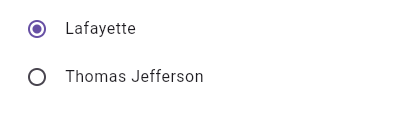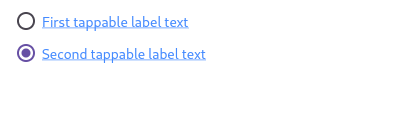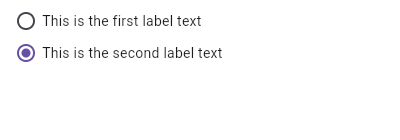| // Copyright 2014 The Flutter Authors. All rights reserved. |
| // Use of this source code is governed by a BSD-style license that can be |
| // found in the LICENSE file. |
| |
| import 'package:flutter/widgets.dart'; |
| |
| import 'list_tile.dart'; |
| import 'list_tile_theme.dart'; |
| import 'material_state.dart'; |
| import 'radio.dart'; |
| import 'radio_theme.dart'; |
| import 'theme.dart'; |
| import 'theme_data.dart'; |
| |
| // Examples can assume: |
| // void setState(VoidCallback fn) { } |
| // enum Meridiem { am, pm } |
| // enum SingingCharacter { lafayette } |
| // late SingingCharacter? _character; |
| |
| /// A [ListTile] with a [Radio]. In other words, a radio button with a label. |
| /// |
| /// The entire list tile is interactive: tapping anywhere in the tile selects |
| /// the radio button. |
| /// |
| /// The [value], [groupValue], [onChanged], and [activeColor] properties of this |
| /// widget are identical to the similarly-named properties on the [Radio] |
| /// widget. The type parameter `T` serves the same purpose as that of the |
| /// [Radio] class' type parameter. |
| /// |
| /// The [title], [subtitle], [isThreeLine], and [dense] properties are like |
| /// those of the same name on [ListTile]. |
| /// |
| /// The [selected] property on this widget is similar to the [ListTile.selected] |
| /// property. This tile's [activeColor] is used for the selected item's text color, or |
| /// the theme's [ThemeData.toggleableActiveColor] if [activeColor] is null. |
| /// |
| /// This widget does not coordinate the [selected] state and the |
| /// [checked] state; to have the list tile appear selected when the |
| /// radio button is the selected radio button, set [selected] to true |
| /// when [value] matches [groupValue]. |
| /// |
| /// The radio button is shown on the left by default in left-to-right languages |
| /// (i.e. the leading edge). This can be changed using [controlAffinity]. The |
| /// [secondary] widget is placed on the opposite side. This maps to the |
| /// [ListTile.leading] and [ListTile.trailing] properties of [ListTile]. |
| /// |
| /// This widget requires a [Material] widget ancestor in the tree to paint |
| /// itself on, which is typically provided by the app's [Scaffold]. |
| /// The [tileColor], and [selectedTileColor] are not painted by the |
| /// [RadioListTile] itself but by the [Material] widget ancestor. In this |
| /// case, one can wrap a [Material] widget around the [RadioListTile], e.g.: |
| /// |
| /// {@tool snippet} |
| /// ```dart |
| /// ColoredBox( |
| /// color: Colors.green, |
| /// child: Material( |
| /// child: RadioListTile<Meridiem>( |
| /// tileColor: Colors.red, |
| /// title: const Text('AM'), |
| /// groupValue: Meridiem.am, |
| /// value: Meridiem.am, |
| /// onChanged:(Meridiem? value) { }, |
| /// ), |
| /// ), |
| /// ) |
| /// ``` |
| /// {@end-tool} |
| /// |
| /// ## Performance considerations when wrapping [RadioListTile] with [Material] |
| /// |
| /// Wrapping a large number of [RadioListTile]s individually with [Material]s |
| /// is expensive. Consider only wrapping the [RadioListTile]s that require it |
| /// or include a common [Material] ancestor where possible. |
| /// |
| /// To show the [RadioListTile] as disabled, pass null as the [onChanged] |
| /// callback. |
| /// |
| /// {@tool dartpad} |
| ///  |
| /// |
| /// This widget shows a pair of radio buttons that control the `_character` |
| /// field. The field is of the type `SingingCharacter`, an enum. |
| /// |
| /// ** See code in examples/api/lib/material/radio_list_tile/radio_list_tile.0.dart ** |
| /// {@end-tool} |
| /// |
| /// ## Semantics in RadioListTile |
| /// |
| /// Since the entirety of the RadioListTile is interactive, it should represent |
| /// itself as a single interactive entity. |
| /// |
| /// To do so, a RadioListTile widget wraps its children with a [MergeSemantics] |
| /// widget. [MergeSemantics] will attempt to merge its descendant [Semantics] |
| /// nodes into one node in the semantics tree. Therefore, RadioListTile will |
| /// throw an error if any of its children requires its own [Semantics] node. |
| /// |
| /// For example, you cannot nest a [RichText] widget as a descendant of |
| /// RadioListTile. [RichText] has an embedded gesture recognizer that |
| /// requires its own [Semantics] node, which directly conflicts with |
| /// RadioListTile's desire to merge all its descendants' semantic nodes |
| /// into one. Therefore, it may be necessary to create a custom radio tile |
| /// widget to accommodate similar use cases. |
| /// |
| /// {@tool dartpad} |
| ///  |
| /// |
| /// Here is an example of a custom labeled radio widget, called |
| /// LinkedLabelRadio, that includes an interactive [RichText] widget that |
| /// handles tap gestures. |
| /// |
| /// ** See code in examples/api/lib/material/radio_list_tile/radio_list_tile.1.dart ** |
| /// {@end-tool} |
| /// |
| /// ## RadioListTile isn't exactly what I want |
| /// |
| /// If the way RadioListTile pads and positions its elements isn't quite what |
| /// you're looking for, you can create custom labeled radio widgets by |
| /// combining [Radio] with other widgets, such as [Text], [Padding] and |
| /// [InkWell]. |
| /// |
| /// {@tool dartpad} |
| ///  |
| /// |
| /// Here is an example of a custom LabeledRadio widget, but you can easily |
| /// make your own configurable widget. |
| /// |
| /// ** See code in examples/api/lib/material/radio_list_tile/radio_list_tile.2.dart ** |
| /// {@end-tool} |
| /// |
| /// See also: |
| /// |
| /// * [ListTileTheme], which can be used to affect the style of list tiles, |
| /// including radio list tiles. |
| /// * [CheckboxListTile], a similar widget for checkboxes. |
| /// * [SwitchListTile], a similar widget for switches. |
| /// * [ListTile] and [Radio], the widgets from which this widget is made. |
| class RadioListTile<T> extends StatelessWidget { |
| /// Creates a combination of a list tile and a radio button. |
| /// |
| /// The radio tile itself does not maintain any state. Instead, when the radio |
| /// button is selected, the widget calls the [onChanged] callback. Most |
| /// widgets that use a radio button will listen for the [onChanged] callback |
| /// and rebuild the radio tile with a new [groupValue] to update the visual |
| /// appearance of the radio button. |
| /// |
| /// The following arguments are required: |
| /// |
| /// * [value] and [groupValue] together determine whether the radio button is |
| /// selected. |
| /// * [onChanged] is called when the user selects this radio button. |
| const RadioListTile({ |
| super.key, |
| required this.value, |
| required this.groupValue, |
| required this.onChanged, |
| this.toggleable = false, |
| this.activeColor, |
| this.title, |
| this.subtitle, |
| this.isThreeLine = false, |
| this.dense, |
| this.secondary, |
| this.selected = false, |
| this.controlAffinity = ListTileControlAffinity.platform, |
| this.autofocus = false, |
| this.contentPadding, |
| this.shape, |
| this.tileColor, |
| this.selectedTileColor, |
| this.visualDensity, |
| this.focusNode, |
| this.onFocusChange, |
| this.enableFeedback, |
| }) : assert(toggleable != null), |
| assert(isThreeLine != null), |
| assert(!isThreeLine || subtitle != null), |
| assert(selected != null), |
| assert(controlAffinity != null), |
| assert(autofocus != null); |
| |
| /// The value represented by this radio button. |
| final T value; |
| |
| /// The currently selected value for this group of radio buttons. |
| /// |
| /// This radio button is considered selected if its [value] matches the |
| /// [groupValue]. |
| final T? groupValue; |
| |
| /// Called when the user selects this radio button. |
| /// |
| /// The radio button passes [value] as a parameter to this callback. The radio |
| /// button does not actually change state until the parent widget rebuilds the |
| /// radio tile with the new [groupValue]. |
| /// |
| /// If null, the radio button will be displayed as disabled. |
| /// |
| /// The provided callback will not be invoked if this radio button is already |
| /// selected. |
| /// |
| /// The callback provided to [onChanged] should update the state of the parent |
| /// [StatefulWidget] using the [State.setState] method, so that the parent |
| /// gets rebuilt; for example: |
| /// |
| /// ```dart |
| /// RadioListTile<SingingCharacter>( |
| /// title: const Text('Lafayette'), |
| /// value: SingingCharacter.lafayette, |
| /// groupValue: _character, |
| /// onChanged: (SingingCharacter? newValue) { |
| /// setState(() { |
| /// _character = newValue; |
| /// }); |
| /// }, |
| /// ) |
| /// ``` |
| final ValueChanged<T?>? onChanged; |
| |
| /// Set to true if this radio list tile is allowed to be returned to an |
| /// indeterminate state by selecting it again when selected. |
| /// |
| /// To indicate returning to an indeterminate state, [onChanged] will be |
| /// called with null. |
| /// |
| /// If true, [onChanged] can be called with [value] when selected while |
| /// [groupValue] != [value], or with null when selected again while |
| /// [groupValue] == [value]. |
| /// |
| /// If false, [onChanged] will be called with [value] when it is selected |
| /// while [groupValue] != [value], and only by selecting another radio button |
| /// in the group (i.e. changing the value of [groupValue]) can this radio |
| /// list tile be unselected. |
| /// |
| /// The default is false. |
| /// |
| /// {@tool dartpad} |
| /// This example shows how to enable deselecting a radio button by setting the |
| /// [toggleable] attribute. |
| /// |
| /// ** See code in examples/api/lib/material/radio_list_tile/radio_list_tile.toggleable.0.dart ** |
| /// {@end-tool} |
| final bool toggleable; |
| |
| /// The color to use when this radio button is selected. |
| /// |
| /// Defaults to [ColorScheme.secondary] of the current [Theme]. |
| final Color? activeColor; |
| |
| /// The primary content of the list tile. |
| /// |
| /// Typically a [Text] widget. |
| final Widget? title; |
| |
| /// Additional content displayed below the title. |
| /// |
| /// Typically a [Text] widget. |
| final Widget? subtitle; |
| |
| /// A widget to display on the opposite side of the tile from the radio button. |
| /// |
| /// Typically an [Icon] widget. |
| final Widget? secondary; |
| |
| /// Whether this list tile is intended to display three lines of text. |
| /// |
| /// If false, the list tile is treated as having one line if the subtitle is |
| /// null and treated as having two lines if the subtitle is non-null. |
| final bool isThreeLine; |
| |
| /// Whether this list tile is part of a vertically dense list. |
| /// |
| /// If this property is null then its value is based on [ListTileThemeData.dense]. |
| final bool? dense; |
| |
| /// Whether to render icons and text in the [activeColor]. |
| /// |
| /// No effort is made to automatically coordinate the [selected] state and the |
| /// [checked] state. To have the list tile appear selected when the radio |
| /// button is the selected radio button, set [selected] to true when [value] |
| /// matches [groupValue]. |
| /// |
| /// Normally, this property is left to its default value, false. |
| final bool selected; |
| |
| /// Where to place the control relative to the text. |
| final ListTileControlAffinity controlAffinity; |
| |
| /// {@macro flutter.widgets.Focus.autofocus} |
| final bool autofocus; |
| |
| /// Defines the insets surrounding the contents of the tile. |
| /// |
| /// Insets the [Radio], [title], [subtitle], and [secondary] widgets |
| /// in [RadioListTile]. |
| /// |
| /// When null, `EdgeInsets.symmetric(horizontal: 16.0)` is used. |
| final EdgeInsetsGeometry? contentPadding; |
| |
| /// Whether this radio button is checked. |
| /// |
| /// To control this value, set [value] and [groupValue] appropriately. |
| bool get checked => value == groupValue; |
| |
| /// If specified, [shape] defines the shape of the [RadioListTile]'s [InkWell] border. |
| final ShapeBorder? shape; |
| |
| /// If specified, defines the background color for `RadioListTile` when |
| /// [RadioListTile.selected] is false. |
| final Color? tileColor; |
| |
| /// If non-null, defines the background color when [RadioListTile.selected] is true. |
| final Color? selectedTileColor; |
| |
| /// Defines how compact the list tile's layout will be. |
| /// |
| /// {@macro flutter.material.themedata.visualDensity} |
| final VisualDensity? visualDensity; |
| |
| /// {@macro flutter.widgets.Focus.focusNode} |
| final FocusNode? focusNode; |
| |
| /// {@macro flutter.material.inkwell.onFocusChange} |
| final ValueChanged<bool>? onFocusChange; |
| |
| /// {@macro flutter.material.ListTile.enableFeedback} |
| /// |
| /// See also: |
| /// |
| /// * [Feedback] for providing platform-specific feedback to certain actions. |
| final bool? enableFeedback; |
| |
| @override |
| Widget build(BuildContext context) { |
| final Widget control = Radio<T>( |
| value: value, |
| groupValue: groupValue, |
| onChanged: onChanged, |
| toggleable: toggleable, |
| activeColor: activeColor, |
| materialTapTargetSize: MaterialTapTargetSize.shrinkWrap, |
| autofocus: autofocus, |
| ); |
| Widget? leading, trailing; |
| switch (controlAffinity) { |
| case ListTileControlAffinity.leading: |
| case ListTileControlAffinity.platform: |
| leading = control; |
| trailing = secondary; |
| break; |
| case ListTileControlAffinity.trailing: |
| leading = secondary; |
| trailing = control; |
| break; |
| } |
| final ThemeData theme = Theme.of(context); |
| final RadioThemeData radioThemeData = RadioTheme.of(context); |
| final Set<MaterialState> states = <MaterialState>{ |
| if (selected) MaterialState.selected, |
| }; |
| final Color effectiveActiveColor = activeColor |
| ?? radioThemeData.fillColor?.resolve(states) |
| ?? theme.colorScheme.secondary; |
| return MergeSemantics( |
| child: ListTile( |
| selectedColor: effectiveActiveColor, |
| leading: leading, |
| title: title, |
| subtitle: subtitle, |
| trailing: trailing, |
| isThreeLine: isThreeLine, |
| dense: dense, |
| enabled: onChanged != null, |
| shape: shape, |
| tileColor: tileColor, |
| selectedTileColor: selectedTileColor, |
| onTap: onChanged != null ? () { |
| if (toggleable && checked) { |
| onChanged!(null); |
| return; |
| } |
| if (!checked) { |
| onChanged!(value); |
| } |
| } : null, |
| selected: selected, |
| autofocus: autofocus, |
| contentPadding: contentPadding, |
| visualDensity: visualDensity, |
| focusNode: focusNode, |
| onFocusChange: onFocusChange, |
| enableFeedback: enableFeedback, |
| ), |
| ); |
| } |
| } |